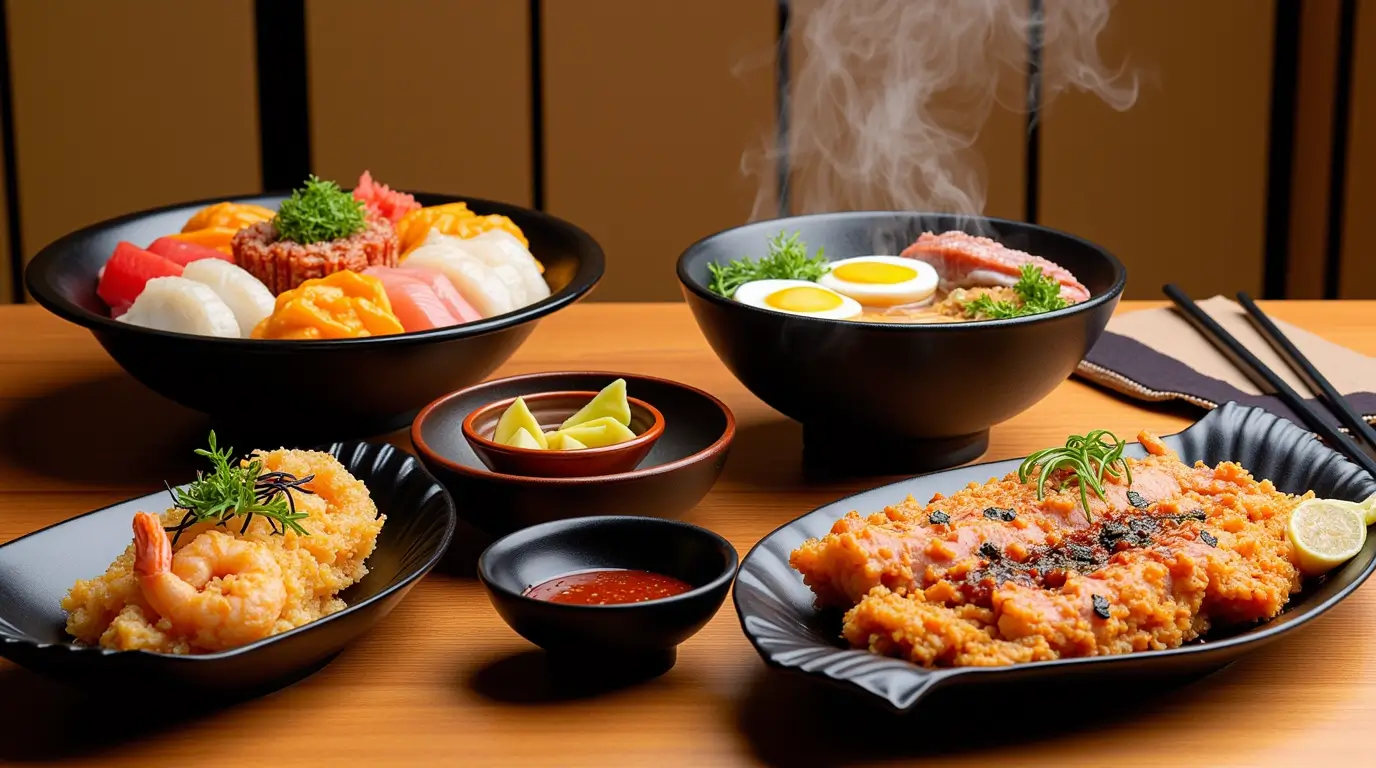Table of Contents
Introduction
Japan’s culinary heritage is a tapestry of ancient traditions, regional distinctions, and modern influences. Often celebrated for its elegance, precision, and unique flavors, Japanese cuisine is renowned around the world for both its visual appeal and thoughtful use of ingredients. From delicate sushi slices draped over vinegared rice to heartwarming bowls of ramen rich with umami, Japanese food has captivated countless palates and continues to evolve with the changing times.
Yet there is so much more to Japanese gastronomy than the dishes that have gained global fame. At its core, Japan’s cuisine reflects a deep respect for nature, underpinned by the concept of shun—the idea of enjoying foods at their peak season. This principle has not only shaped Japanese cooking techniques but has also influenced the rhythm of daily meals and, ultimately, the country’s relationship with its environment. From the northern island of Hokkaido, known for its fresh seafood and dairy, to the subtropical regions of Okinawa, famous for its longevity-inducing diet, Japan’s diverse geography has given rise to a plethora of local specialties.
Over the centuries, migration, trade, and cultural exchange have also left their marks on Japanese cuisine. Adaptations from Chinese, Portuguese, and more recently, Western culinary traditions mingle effortlessly with time-honored cooking methods and seasonal ingredients. Although it is often associated with fastidious detail and refined presentation, Japanese food is also comforting and abundant in soul-warming staples. In the sections that follow, we will delve into the stories, flavors, and rituals that define Japan’s culinary landscape, guiding you through its history, iconic ingredients, and must-try dishes. Whether you are new to Japanese cuisine or eager to deepen your appreciation, this exploration aims to bring a taste of Japan’s gastronomic world right to your table.
Culinary Context and History
Historical Evolution
Japan’s cuisine has been shaped by millennia of cultural, political, and environmental shifts. In its earliest days, when the country was primarily an agrarian society, the diet revolved around rice, fish, and vegetables. Archaeological evidence reveals that rice, introduced from mainland Asia around 300 BCE, quickly became a staple crop. Coupled with a coastline teeming with seafood, it is no surprise that Japan’s culinary foundation was defined by fresh fish and rice-based dishes.
Buddhism, introduced from China in the 6th century, brought about a profound influence on eating habits. Vegetarianism became more prominent among monks, and the general population reduced meat consumption, leading to the increased use of soy products such as tofu and miso. Monastic cuisine (known as shōjin ryōri) flourished in temple complexes, focusing on simple, seasonal vegetables prepared in ways that honored Buddhist principles of non-violence. Though meat did not disappear entirely, it waned in popularity for several centuries.
The Kamakura (1185–1333) and Muromachi (1336–1573) periods saw a consolidation of courtly cuisine, known as yūsoku ryōri, which emphasized meticulous presentation for the aristocracy. Tea ceremonies also emerged during this time, elevating the practice of savoring flavors in a refined, almost ritualistic manner. This ceremonial aspect of mealtime helped set a precedent for the attentive and artful way that modern Japanese dishes are often presented.
Notable foreign influences include the Portuguese in the 16th century, who introduced tempura (a dish originally based on fritter-cooking methods). Later, when Japan’s centuries-long isolation (the Edo period from 1603–1868) ended with the Meiji Restoration in 1868, Western cuisines gained popularity. This ushered in dishes like yōshoku, which fuse Western cooking techniques with Japanese ingredients—such as tonkatsu (breaded pork cutlet) and curry rice (inspired by British-style curry, originally from India).
Regional Influences
Japan’s geography, stretching from the cold and snowy north of Hokkaido to the subtropical islands of Okinawa, has spawned a remarkable diversity in local cuisines.
- Hokkaido (North): Known for its robust dairy industry—unique in Japan—Hokkaido is famous for butter corn ramen and rich soft-serve ice cream. The cold waters around this island yield some of the country’s finest salmon, crab, and sea urchin.
- Tohoku Region (Northeast Honshu): Tohoku is famed for its hearty stews, pickled vegetables, and sake production. The region’s harsh winters led to preservation techniques such as fermentation, resulting in tangy or umami-rich flavors.
- Kanto Region (Eastern Honshu): Home to Tokyo, this region is known for bold, soy sauce–heavy seasonings in dishes like Edo-style sushi (thin slices of fish pressed onto vinegared rice). The Kanto style of soba and udon noodles typically features darker, saltier broths.
- Kansai Region (Western Honshu): Osaka, Kyoto, and Kobe anchor this food-loving region. Kansai cuisine is often described as more delicate in flavor. Kyoto’s kaiseki cuisine highlights the art of seasonal presentation, while Osaka is known for its street foods like takoyaki (octopus balls) and okonomiyaki (savory pancakes).
- Kyushu (Southwest): Known for tonkotsu ramen, Kyushu boasts pork-based broths and a strong emphasis on local produce, sweet potatoes, and fresh citrus.
- Okinawa (Far South): Due to its distance from the main islands and historical ties to the Ryukyu Kingdom, Okinawa’s cuisine has distinctive elements. A diet rich in vegetables like bitter melon (goya), pork, and tofu is believed to contribute to Okinawans’ famously high life expectancy.
Throughout these regions, Japan’s culinary development has been influenced by both domestic travel and international exchanges. Trade routes introduced new seasonings, cooking methods, and even table customs. Today, modern technology and efficient transportation allow people to sample specialties from every corner of Japan without leaving major cities. Yet, local communities still preserve time-honored recipes passed down through generations, ensuring that Japan’s culinary landscape remains richly varied and deeply rooted in history.
Key Ingredients and Local Products
Emblematic Foods
Japanese cuisine is defined by its fundamental ingredients and the care with which they are prepared:
- Rice (Gohan): The backbone of the Japanese diet, short-grain japonica rice is sticky and slightly sweet. It is the cornerstone of main dishes such as sushi, onigiri (rice balls), and the ever-present bowl of plain steamed rice.
- Soy Products: This includes soy sauce (shōyu), miso (fermented soybean paste), tofu, and natto (fermented soybeans). These products contribute significant umami and form the basis of countless dishes and soups.
- Seafood: Given Japan’s extensive coastline, fish and shellfish—such as salmon, tuna, mackerel, crab, and shrimp—are integral. Seaweed, including nori, wakame, and kombu, further adds to the oceanic flavor profile and provides minerals.
- Dashi: A foundational stock made from kombu (kelp) and katsuobushi (dried bonito flakes). Some variants add dried sardines or dried shiitake mushrooms. Dashi underpins the characteristic savory depth found in miso soup, ramen broth, and countless other dishes.
- Seasonal Vegetables & Fruits: Daikon (Japanese radish), burdock root (gobo), lotus root (renkon), and an array of mushrooms are common. Fruits like yuzu (citrus) and persimmons also have special prominence in Japanese meals.
- Wasabi & Other Condiments: Fresh wasabi root—grated to produce a pungent green paste—adds sharpness to sushi and sashimi. Pickled ginger (gari), pickled plums (umeboshi), and Japanese mustard (karashi) are additional condiments that enliven dishes.
Seasonality
The importance of shun—eating foods at their seasonal best—cannot be overstated in Japanese cooking. Restaurants and home kitchens alike highlight special produce when it is at its freshest, adjusting menus accordingly. Spring features bamboo shoots and sweet green peas; summer calls for cooling dishes featuring cucumbers, tomatoes, and cold noodles; autumn is the time for matsutake mushrooms and sweet potatoes; and winter embraces root vegetables and hot pot dishes. The respect for seasonality is not merely practical—maximizing flavor and nutrition—but also cultural, as it aligns meals with seasonal festivals and celebrations.
Purchasing Tips
Outside of Japan, key Japanese ingredients can be found at Asian supermarkets, specialty grocery stores, or online. Look for:
- Short-grain Rice: Brands labeled “sushi rice” or “Japanese short-grain rice.”
- Soy Sauce and Miso: Opt for authentic Japanese brands; check ingredient labels for quality.
- Seafood: For sushi or sashimi-grade fish, rely on trusted local fishmongers.
- Seaweed & Dashi Ingredients: Kombu and bonito flakes are increasingly available in well-stocked international aisles.
- Vegetables & Condiments: Wasabi paste can be purchased in tubes, though real wasabi root is harder to find. Fresh produce like daikon and Japanese eggplants appear in many farmers’ markets with an interest in global produce.
By selecting these essential items and learning to appreciate their nuances, home cooks can recreate the heart of Japanese cuisine anywhere in the world.
Must-Try Traditional Dishes
Sushi and Sashimi
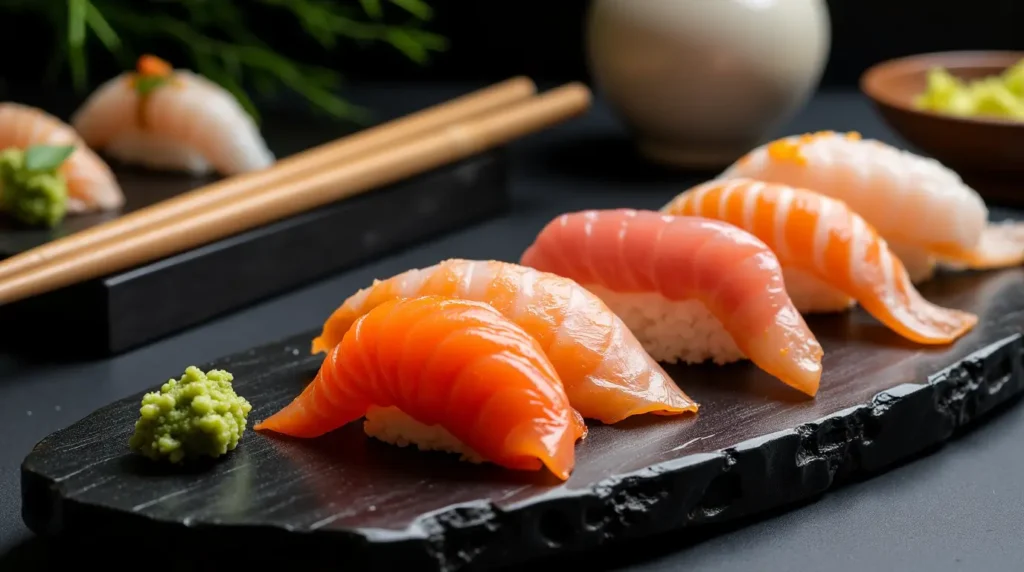
Sushi might be the most internationally recognized Japanese dish. Originally developed as a method of preserving fish in fermented rice, modern Edo-mae (Tokyo-style) sushi is composed of vinegared rice topped with fresh fish or seafood. Sashimi, on the other hand, refers solely to thinly sliced raw fish or meat without the rice. The skill lies in selecting the freshest ingredients and slicing them precisely.
- History: Sushi’s roots can be traced to Southeast Asia’s ancient practice of fermenting fish. Over centuries, Japanese cooks adapted these methods, eventually discarding fermentation in favor of fresh fish. By the 19th century, sushi stalls in Edo (Tokyo) were serving nigiri-sushi, a form that has become standard worldwide.
- Recipe Tip: For a simplified version at home, begin with sushi rice (seasoned with vinegar, sugar, and salt). Mold small oval shapes, and top them with very fresh, thinly sliced fish such as salmon or tuna. Lightly press to secure. Serve with soy sauce and a small dab of wasabi.
Tempura
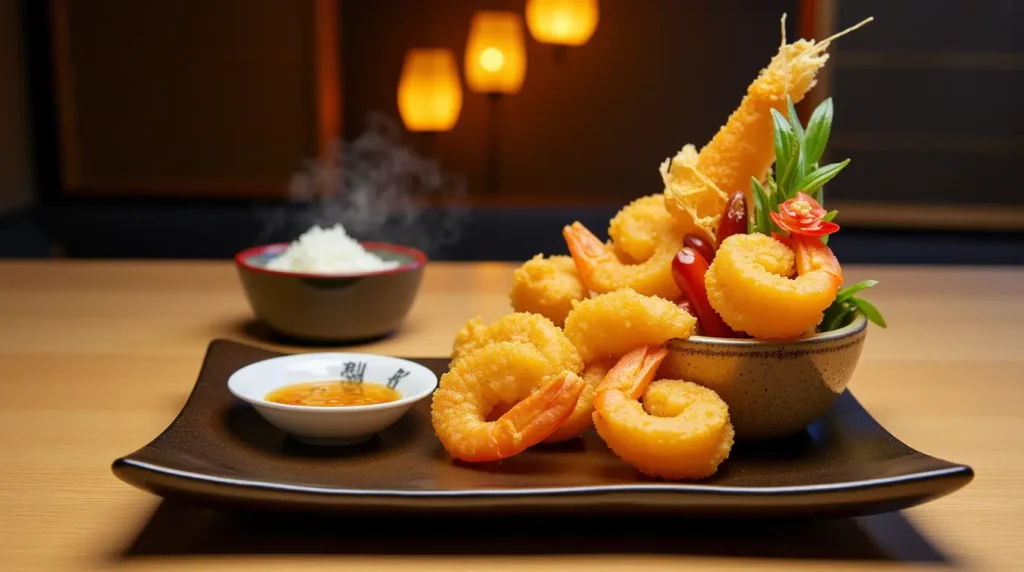
Tempura involves dipping shrimp, fish, or vegetables in a light batter—often made from flour, cold water, and sometimes egg—before briefly deep-frying them. The result is a delicately crispy coating that doesn’t overpower the natural flavor of the ingredients.
- History: Brought by Portuguese missionaries in the 16th century, the fritter style was adapted to local tastes, becoming tempura. It gained fame during the Edo period as a popular street food.
- Recipe Tip: Use ice-cold water and avoid over-mixing the batter to achieve that signature airy crisp. Serve with tentsuyu dipping sauce (a combination of dashi, soy sauce, and mirin) and grated daikon for a refreshing finish.
Ramen
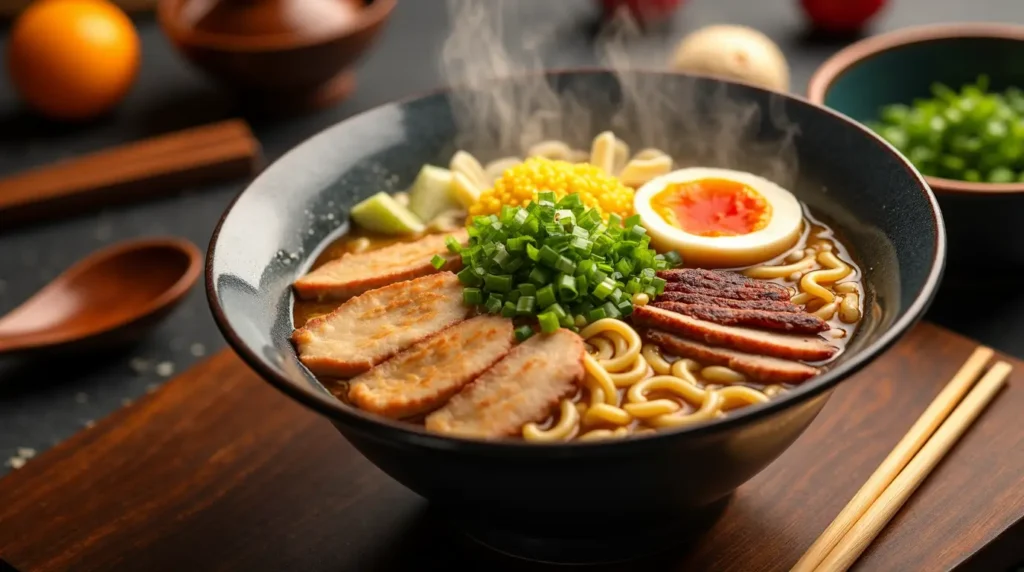
Although ramen traces its origins to Chinese noodles, it has become an icon of Japanese comfort food. Different regions offer their own versions: shōyu (soy sauce) ramen in Tokyo, miso ramen in Hokkaido, and tonkotsu (pork bone) ramen in Kyushu, among others.
- History: The dish soared in popularity after World War II, when wheat flour became more abundant in Japan. Over time, ramen shops perfected their broths, making them a true art form.
- Recipe Tip: To create a simple miso ramen at home, prepare chicken or vegetable stock, add miso paste, garlic, and ginger, then simmer. Cook store-bought ramen noodles separately, place them in a bowl, and ladle over the hot broth. Top with sliced chashu pork, soft-boiled eggs, and chopped green onions.
Okonomiyaki
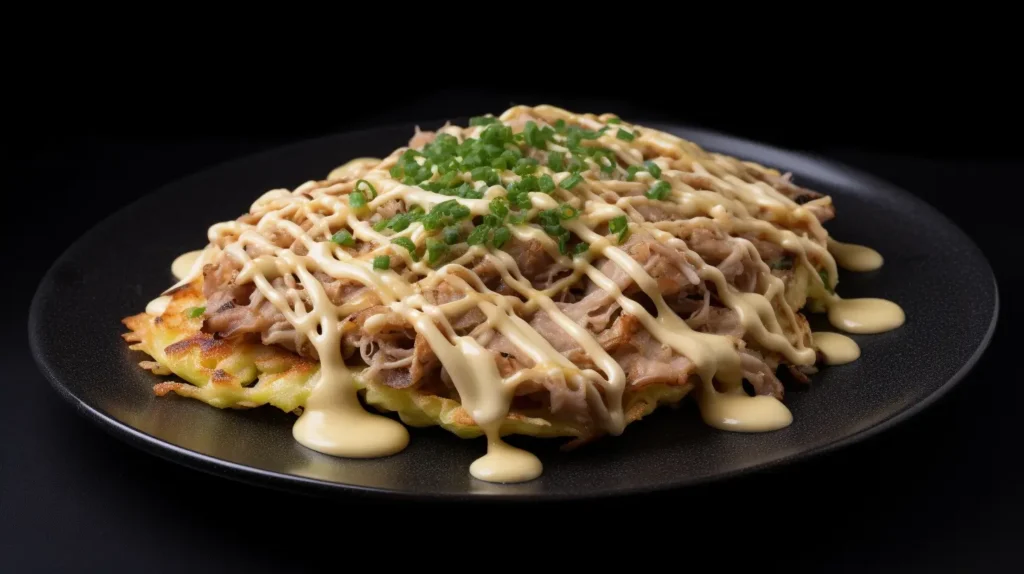
A savory pancake whose name translates to “grill what you like,” okonomiyaki is typically made with a batter of flour, grated yam, dashi, and chopped cabbage. Toppings range from thinly sliced pork belly to seafood and cheese, with a drizzle of sweet-salty sauce and mayonnaise on top.
- Regional Variations: The Kansai-style (especially Osaka) involves mixing all ingredients into the batter before cooking, while Hiroshima-style layers the ingredients and often adds noodles as well.
- Recipe Tip: For a home-friendly version, mix flour, water or dashi, and shredded cabbage into a thick batter. Add diced seafood or thinly sliced pork. Cook on a hot skillet, flip, and garnish with okonomiyaki sauce, Japanese mayonnaise, and bonito flakes.
These must-try dishes illustrate the depth and variety of Japan’s food culture. Whether you are sampling sushi at a high-end restaurant or grilling okonomiyaki on a home teppan (iron griddle), each bite offers a glimpse into a living culinary tradition.
Defining Characteristics of Japanese Cuisine
One of the primary hallmarks of Japanese cuisine is its delicate balance of flavors, often leaning toward subtlety rather than strong spiciness or heavy seasoning. Where some cuisines dazzle the palate with an array of bold spices, Japanese cooking tends to revolve around the concept of umami, the so-called “fifth taste.” This savory depth is imparted by ingredients like dashi, soy sauce, miso, and certain mushrooms. Even in more robust dishes such as tonkotsu ramen, the emphasis is on a layered, comforting flavor rather than overt spiciness.
Sweet and salty also feature prominently, with mirin (sweet rice wine) and sugar balancing the saltiness of soy sauce in sauces, marinades, and glazes. This interplay is well exemplified in teriyaki—a sweet-savory sauce that can coat fish, chicken, or beef, giving it a glossy finish and rich taste. For those seeking a spicy kick, condiments like wasabi, karashi (Japanese mustard), or shichimi togarashi (a seven-spice blend) can be added, but they are typically used sparingly to enhance flavors rather than overwhelm them.
Traditional Japanese meals usually consist of multiple small dishes, each providing different textures and tastes. A typical meal layout might include a bowl of rice, miso soup, pickles (tsukemono), and a main dish like grilled fish or simmered vegetables. Presentation is also crucial—ingredients are arranged thoughtfully, often drawing inspiration from nature or reflecting the season at hand.
For food enthusiasts looking for new gastronomic experiences, Japanese cuisine offers a compelling blend of refined simplicity and complexity. The dishes may appear minimalistic, but beneath that simplicity lies careful technique and a strong emphasis on quality ingredients. This focus on harmony, balance, and respect for natural tastes is what sets Japanese food apart. It invites diners to slow down, appreciate the small details, and ultimately discover just how flavors can be elevated when less is sometimes more.
Tips and Highlights to Encourage People to Try Japanese Cuisine
If you’re intrigued by subtlety, balanced flavors, and the stories behind each dish, Japanese cuisine is a treasure trove worth exploring. Here are some compelling reasons to dive into this culinary world:
- Variety and Depth: While sushi and ramen often take the spotlight, Japan offers an astonishing range of dishes, from light tofu preparations to hearty hot pots. Even the same type of food, like noodles, can differ dramatically from region to region, ensuring a continuous journey of discovery.
- Seasonal Appreciation: The emphasis on shun or seasonal eating makes dining an ever-changing experience. Chefs and home cooks alike pay close attention to what nature provides at any given time, ensuring fresher, tastier meals.
- Respect for Ingredients: Minimal waste and maximum flavor is a guiding principle in Japanese cooking. This respect extends not just to prime cuts of fish or beef, but also to humbler ingredients such as root vegetables and pickles, which form essential components of meals.
- Cultural Insight: Through food, you get a window into Japanese history, traditions, and values. From tea ceremonies to bento box art, the culinary realm showcases the country’s blend of formality, creativity, and deep-rooted customs.
- Approachability: Many Japanese dishes can be recreated at home with a few key ingredients. Even if you’re a beginner, learning to cook simple miso soup or basic sushi rolls can be a fun and rewarding introduction.
By embracing the unique flavors and philosophies of Japanese cuisine, you’ll not only expand your palate but also gain a deeper appreciation for a culture that celebrates harmony, innovation, and respect for nature.
Table Rituals and Customs
Typical Meals
Japanese meals typically follow a balanced structure— ichijū-sansai—meaning “one soup, three dishes.” While this custom can vary according to modern lifestyles, it underscores the ideal ratio of soup, main dishes, and side dishes.
- Breakfast (Asa-gohan): Traditionally, a Japanese breakfast may include steamed rice, miso soup, grilled fish, and pickles. Some families also add a small rolled omelet (tamagoyaki) or natto. Although Western-style breakfasts are common today, many still appreciate a traditional start to the day.
- Lunch (Hiru-gohan): Office workers often grab bento boxes or quick noodle soups like udon or soba. Bento, which can be homemade or store-bought, features a selection of rice, proteins, and vegetables.
- Dinner (Ban-gohan): Dinner is often the most substantial meal, with dishes that can range from fish or meat with rice and soup to a communal hot pot (nabe) shared with family members.
Key Moments and Etiquette
- Chopstick Use: Improper chopstick manners (like passing food from chopstick to chopstick, or sticking them upright in a bowl of rice) can be considered rude or reminiscent of funeral rituals.
- Saying Grace: Before eating, it’s customary to say “Itadakimasu,” literally meaning “I humbly receive,” expressing gratitude. After finishing, “Gochisōsama deshita” (“It was a feast”) is used to thank the cook or host.
- Drinking Etiquette: In Japan, it’s polite to wait for everyone to be served before raising your glass for a toast, usually accompanied by “Kanpai!”.
National Holidays and Culinary Traditions
- New Year’s (Oshōgatsu): The most significant holiday in Japan. Families prepare or purchase osechi ryōri, a variety of small dishes packed in lacquer boxes (jubako). Each dish carries symbolic meaning—shrimp for longevity, black soybeans for health, and so forth.
- Cherry Blossom Viewing (Hanami): In spring, people gather under blooming sakura trees to picnic. Special bento, sake, and seasonal treats like sakura mochi are consumed in a celebratory atmosphere.
- Doll’s Festival (Hinamatsuri): Celebrated in March, families with daughters display ornamental dolls and enjoy chirashizushi (scattered sushi) and colorful rice crackers.
- Autumn Festivals (Aki Matsuri): Seasonal harvest festivals celebrate new rice and produce. Grilled sweet potatoes and other autumn delicacies are enjoyed in street stalls or at home.
From carefully composed bento boxes to elaborate New Year feasts, table rituals in Japan emphasize harmony, respect, and an appreciation for craftsmanship. These customs give diners a chance to connect deeply with food and each other, reflecting Japan’s cultural essence of gratitude and mindfulness.
Modern Trends and Culinary Fusions
Evolution and Foreign Influences
Japanese cuisine is far from static. Throughout its history, it has absorbed influences from neighboring Asian countries and Western powers, adapting them to fit local tastes. This openness continues today. You’ll find yōshoku restaurants serving hamburg (Japanese-style hamburger steak), omurice (omelet over fried rice), and naporitan (a sweet-savory spaghetti dish said to be inspired by Italian cuisine but heavily modified in Japan). These dishes highlight how Japan refines foreign cuisines into something distinctly its own.
Moreover, the popularity of global cooking shows and social media now encourages Japanese chefs to experiment with fusion ideas. Ramen burgers—where grilled ramen patties replace hamburger buns—and sushi burritos illustrate how creative chefs are marrying different food cultures. While purists might question such mash-ups, they reflect Japan’s long tradition of adaptation and reinvention.
New Consumption Trends
- Vegetarianism and Veganism: Traditionally, Japan’s reliance on fish broth (dashi) in nearly every soup and sauce made true vegetarianism challenging. However, an increasing number of restaurants now offer vegetable-based broths or use kombu or shiitake-based stocks to cater to a growing plant-based clientele.
- Farm-to-Table: As consumers become more conscious of sustainability and health, direct sourcing from farms is on the rise. Some high-end restaurants have their own vegetable gardens or partner with organic farmers to showcase hyper-local produce.
- Organic and Gluten-Free Options: While not as widespread as in Western countries, interest in organic products and gluten-free cooking is expanding. Miso and soy sauces are increasingly available in organic versions, and restaurants are more mindful of dietary restrictions.
Young Chefs and Contemporary Takes
A new generation of Japanese chefs is revisiting traditional dishes and techniques, introducing modern flair while preserving core principles. Many have trained abroad, returning with international techniques and plating styles. Examples include:
- Michelin-Starred Sushi Innovations: Young sushi chefs experiment with aging fish or pairing fish with unexpected ingredients like truffle or olive oil, all while respecting the Edo-mae tradition.
- Creative Kaiseki: Some chefs are pushing the boundaries of kaiseki—a multi-course, seasonally driven meal—by integrating foreign herbs, spices, and plating concepts.
- Rethinking Izakaya Culture: Izakayas (Japanese pubs) now serve inventive small plates that combine Japanese flavors with influences from Southeast Asia, the Mediterranean, or even Latin America.
These developments underscore a dynamic culinary landscape where tradition coexists with innovation. Much like the historical absorption of Chinese and Portuguese elements centuries ago, modern Japanese cuisine continues to evolve, ensuring that there will always be something new to discover.
Conclusion and Call to Action
Japan’s culinary tapestry, woven over centuries, is as diverse as it is refined. From the humble elegance of miso soup to the masterful precision of kaiseki cuisine, each dish tells a story of geography, history, and cultural ethos. The focus on seasonality (shun), respect for ingredients, and artful presentation has not only shaped how the Japanese eat but also influenced global perceptions of taste and dining.
In this exploration, we’ve uncovered the influences that shaped Japanese gastronomy, the regional distinctions that make each part of the country unique, and the traditional and modern approaches that define contemporary Japanese cooking. We’ve delved into key ingredients like rice, soy, and fish, as well as some must-try dishes—sushi, tempura, ramen, and okonomiyaki—that embody Japan’s food identity. We’ve also looked at the rituals surrounding the table, the importance of saying “Itadakimasu” and “Gochisōsama deshita,” and how modern fusion trends and young chefs are rewriting the rules.
We invite you to share your own experiences, favorite recipes, or any burning questions you may have about Japanese cuisine. Whether you decide to try making your first sushi roll at home or dive into the complexities of a miso-based hot pot, exploring Japanese food is a journey that offers endless rewards. Stay tuned for a future article where we’ll explore the world of Japanese tea culture and its profound ties to the nation’s culinary tradition. Until then, kanpai and happy cooking!

